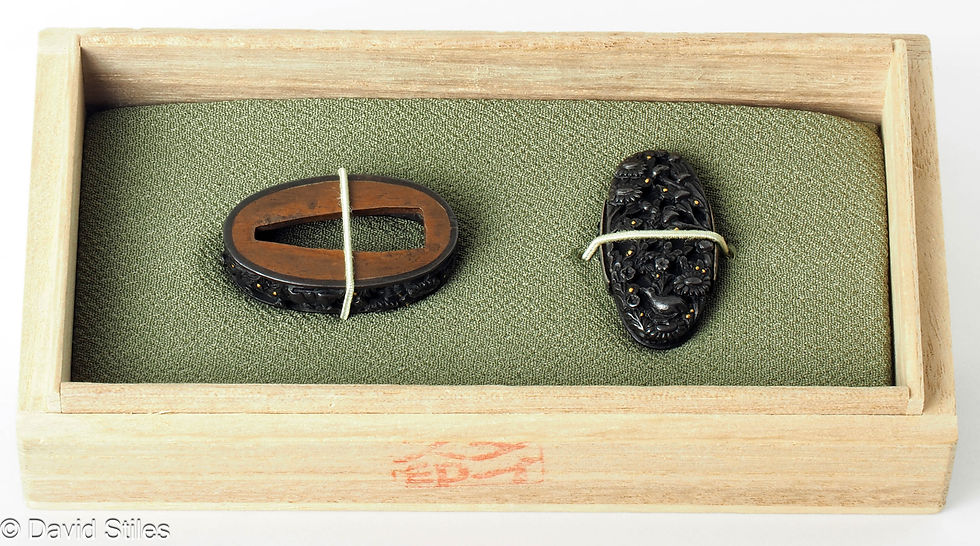(小道具ギャラリー①) Kodōgu Gallery #1




Ko-Kinkō Menuki (古金工目貫)
Japanese Title: 這龍図目貫 (hairyū zu menuki)
Material: Red Copper (Shakudō 赤銅)
Age: Muromachi Period (室町時代)
Size: 4.5 cm
Signature: mumei (無銘)
Surface Finish: Migaki-ji (磨地)
Attachment: Custom Kiri Wood Storage Box, NBTHK Hozon Paper
These are large handle ornaments of a Japanese sword (menuki 目貫) made of the Japanese copper-gold alloy (shakudō 赤銅). The deep black color of the alloy is characteristic of a higher gold content. These menuki date from the Muromachi Period (室町時代) from approximately 1336-1573 and was likely mounted and used on a long but ornately decorated (uchigatana 打刀). The menuki are constructed of a single thin plate shakudō that shows extensive use of openings (nuke-ana 抜穴) to form the design. This along with rectangle shaped posts on the back side are characteristic of menuki from the Muromachi Period.
The design of menuki is of a crawling male and female Japanese style dragon (hairyū 這龍). The male dragon can be distinguished from the female dragon by presence of a double-edged sword (ken 剣) at the end of its tail. In these fine menuki the male dragon is actively grasping the wish-fulfilling jewel while the female dragon looks on with a purposeful indifference. The dragon has long been associated with the rain and the sky. It is also seen as a symbol of good opportunity as well as the emperor.
These menuki were attributed by the NBTHK to the large group of early goldsmiths (Ko-Kinkō 古金工). The appraisal paper (hozon tōsōgu kanteisho 保存刀装具鑑定書) by the (Nihon Bijutsu Hozon Kyokai 日本美術刀剣保存協會) (NBTHK), Society of the Preservation of the Japanese Art Sword, designating it to be of good quality, authentic, and worthy of historical preservation. The paper was issued on July 4, 2015.
References:
1. The Samurai Collection: 9th International Convention & Exhibition by Kokusai Tosogu Kai (KTK), Copyrighted 2013, page 46.
2. Samurai: 8th International Convention & Exhibition by Kokusai Tosogu Kai (KTK), Copyrighted 2012, page 32.
3. The Art Appreciation of Japanese Sword Fittings by Shigeo Fukushi, Copyrighted 2012, page 86.
Provenance: Eric Molinier Collection




Kinkō Menuki (金工目貫)
Japanese Title: 麒麟図目貫 (Kirin no zu menuki)
Material: Copper-Silver Alloy (Shibuichi 四分一)
Age: Middle to Late Edo Period (江戸時代中期~後期)
Size: 3.5 cm long, 2.0 cm wide
Signature: mumei (無銘)
Surface Finish: Migaki-ji (磨地)
Attachment: None
These are ornaments (menuki 目貫) for the handle of the Japanese sword. Due to their overall size they are were likely mounted on used on a long sword (katana 刀). The design is that of the Japanese mythical dragon horse or Chinese unicorn (kirin 麒麟).(1) In Edo Period Japan unlike Qing Dynasty China it is considered one of the most powerful mythical creatures above both the dragon and phoenix. It is frequently referenced in works of literature and art in both China and Japan.(2)
The design is carved in high relief (takabori 高彫). The base metal of these menuki is the copper-silver alloy (shibuichi 四分一) darken naturally with age. I estimate based upon the overall workmanship, high relief style carving style, and use of materials that these menuki were likely made during the middle to late Edo Period (1770 - 1868 CE). I am not sure which school or group could have made them, but fine detail is very nice. More research and study are required.
References:
1. Legend in Japanese Art by Henri L. Joly. John Lane Company ©1908, pages 175-177.
2. Wikipedia Entry for Qilin: https://en.wikipedia.org/wiki/Qilin.
Provenance: David Bond Collection




Ko-Mino Fuchi Gashira (古美濃縁頭)
Japanese Title: ??
Material: Red Copper (Shakudō 赤銅)
Age: Muromachi Period (室町時代)
Size: Fuchi- 3.7 cm X 2.1 cm, Kashira- 3.5 cm X 2.0 cm.
Signature: mumei (無銘)
Surface Finish: Migaki-ji (磨地)
Attachment: None
This remarkable Ko-Mino fuchi-gashira (古美濃縁頭) set that was made for use on long sword (katana 刀). A professional goldsmith (kinkō 金工) professionally and conservatively cleaned this set. When the set was cleaned, nothing was done to the deep rich patina of the copper-gold alloy (shakudō 赤銅). Based upon its coloration of the patina the shakudō alloy was likely made with a lower gold content characteristic of works by the Ko-Mino group.
I estimate that the set based upon the materials and workmanship was made sometime during the Muromachi Period (~1336 to 1573 CE). Due to the age and rarity of such a matching set preservation is of utmost importance. Especially when any restorative cleaning work is even considered. I think the design is that of an Autumn nature scene featuring assortment of grasses, flowers, and animals. I am going to submit the set to NBTHK shinsa later to learn more details.
Provenance: Unknown
